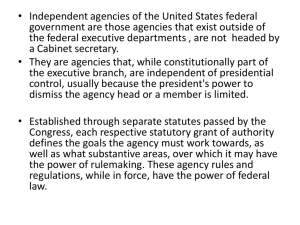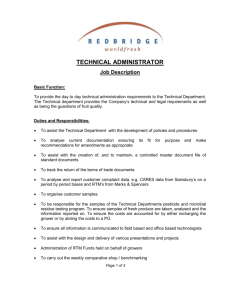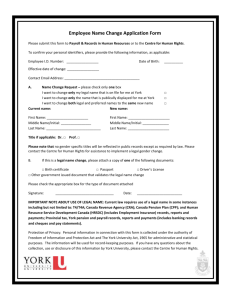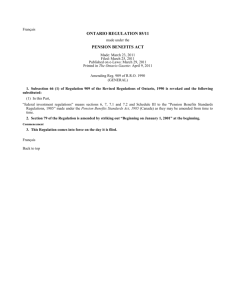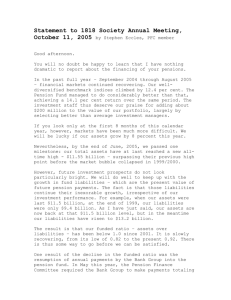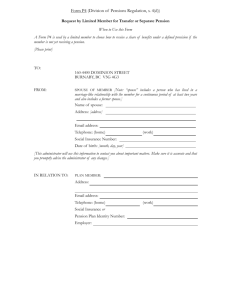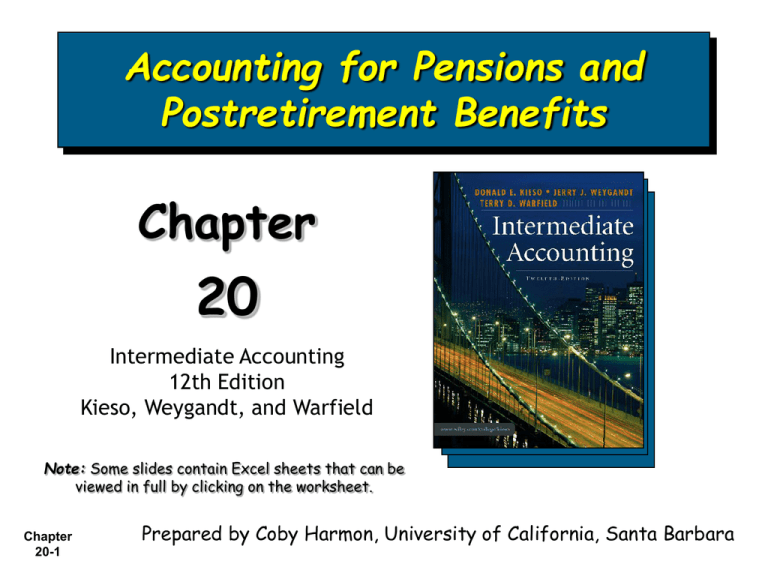
Accounting for Pensions and
Postretirement Benefits
Chapter
20
Intermediate Accounting
12th Edition
Kieso, Weygandt, and Warfield
Note: Some slides contain Excel sheets that can be
viewed in full by clicking on the worksheet.
Chapter
20-1
Prepared by Coby Harmon, University of California, Santa Barbara
Learning Objectives
1.
Distinguish between accounting for the employer’s pension plan
and accounting for the pension fund.
2.
Identify types of pension plans and their characteristics.
3.
Explain alternative measures for valuing the pension obligation.
4.
List the components of pension expense.
5.
Use a worksheet for employer’s pension plan entries.
6.
Describe the amortization of prior service costs.
7.
Explain the accounting procedure for unexpected gains and
losses.
8.
Explain the corridor approach to amortizing gains and losses.
9.
Describe the requirements for reporting pension plans in financial
statements.
Chapter
20-2
Accounting for Pensions and Postretirement Benefits
Nature of
Pension Plans
Accounting
for Pensions
Defined
contribution
plan
Alternative
measures of
liability
Definedbenefit plan
Recognition
of net funded
status
Role of
actuaries
Components
of pension
expense
Using a
Pension
Worksheet
2009 entries and
worksheet
Amortization of
prior service cost
Reporting
Pension Plans
in Financial
Statements
Within the
financial
statements
2010 entries and
worksheet
Within the notes
to the financial
statements
Gain or loss
Disclosure
2011 entries and
worksheet
2012 entries,
comprehensive
example
Special issues
Chapter
20-3
Nature of Pension Plans
A Pension Plan is an arrangement whereby an employer provides
benefits (payments) to employees after they retire for
services they provided while they were working.
Pension Plan
Administrator
Employer
Retired
Employees
Chapter
20-4
Benefit Payments
Assets &
Liabilities
LO 1 Distinguish between accounting for the employer’s
pension plan and accounting for the pension fund.
Nature of Pension Plans
Some pension plans are:
Contributory: employees voluntarily make payments
to increase their benefits.
Noncontributory: employer bears the entire cost.
Qualified pension plans: offer tax benefits.
Pension fund should be a separate legal and
accounting entity.
Chapter
20-5
LO 1 Distinguish between accounting for the employer’s
pension plan and accounting for the pension fund.
Types of Pension Plans
Defined-Contribution Plan
Employer contribution
determined by plan (fixed)
Risk borne by employees
Benefits based on plan value
Defined-Benefit Plan
Benefit determined by plan
Employer contribution varies
(determined by Actuaries)
Risk borne by employer
Actuaries estimate the employer contribution by considering
mortality rates, employee turnover, interest and earning rates,
early retirement frequency, future salaries, etc.
Statement of Financial Accounting Standard No. 158,
“Employers’ Accounting for Defined Pension Plans and
other Postretirement Plans,” 2006
Chapter
20-6
LO 2 Identify types of pension plans and their characteristics.
Accounting for Pensions
Two questions:
(1) What is the pension obligation that a company
should report in the financial statements?
(2) What is the pension expense for the period?
Chapter
20-7
LO 3 Explain alternative measures for valuing the pension obligation.
Accounting for Pensions
The employer’s pension
obligation is the
deferred compensation
obligation it has to its
employees for their
service under the terms
of the pension plan.
Alternative measures of the Liability
Illustration 20-3
FASB’s
choice
Chapter
20-8
LO 3 Explain alternative measures for valuing the pension obligation.
Accounting for Pensions
Recognition of the Net Funded Status of
the Pension Plan
Under the provisions of a recent amendment to SFAS
No. 87, companies must recognize on their balance
sheet the full overfunded or underfunded status of
their defined benefit pension plan.
The overfunded or underfunded status is measured
as the difference between the fair value of the plan
assets and the projected benefit obligation (PBO).
Chapter
20-9
LO 3 Explain alternative measures for valuing the pension obligation.
Accounting for Pensions
Components of Pension Expense
1.
Service Costs
2.
Interest on Liability
3.
Actual Return on Plan Assets
4.
Amortization of Prior Service Costs
5.
Gain or Loss
Chapter
20-10
Effect on
Expense
+
+
+/+/+/-
LO 4 List the components of pension expense.
Accounting for Pensions
Components of Pension Expense
1.
Service Costs
Effect on
Expense
+
Actuarial present value of benefits attributed by
the pension benefit formula to employee service
during the period.
Chapter
20-11
LO 4 List the components of pension expense.
Accounting for Pensions
Components of Pension Expense
2.
Interest on Liability
Effect on
Expense
+
Interest for the period on the projected benefit
obligation outstanding during the period.
The interest rate (settlement rate) should reflect
the rate at which companies can effectively settle
pension benefits.
Chapter
20-12
LO 4 List the components of pension expense.
Accounting for Pensions
Components of Pension Expense
3.
Actual Return on Plan Assets
Effect on
Expense
+/-
The actual return on plan assets is the increase in
pension funds from interest, dividends, and realized
and unrealized changes in the fair-market value of
the plan assets.
Chapter
20-13
LO 4 List the components of pension expense.
Accounting for Pensions
Components of Pension Expense
4.
Amortization of Prior Service Costs
Effect on
Expense
+
Plan amendments often increase benefits for service
provided in prior years.
The cost (prior service cost) of providing these
retroactive benefits is allocated to pension expense
over the remaining service-years of the affected
employees.
Chapter
20-14
LO 4 List the components of pension expense.
Accounting for Pensions
Components of Pension Expense
5.
Gain or Loss
Effect on
Expense
+/-
Volatility in pension expense can result from sudden
and large changes in the market value of plan assets
and by changes in the projected benefit obligation.
Chapter
20-15
LO 4 List the components of pension expense.
Pension Items Not Recognized
Companies do not recognize two main items in the accounts and
in the financial statements:
Projected benefit obligation.
Pension plan assets.
A company must disclose in notes to the financial statements, but
not in the body of the financials.
Some items are recognized in other comprehensive income;
changes in these items are amortized into expense through
smoothing techniques.
Prior service costs.
Actuarial gains and losses.
Chapter
20-16
LO 5 Use a worksheet for employer’s pension plan entries.
Using a Pension Worksheet
Pension Worksheet
Items
Pension
Expense
GENERAL JOURNAL ENTRIES
Other Comprehensive Income
(OCI)
Prior
Service
Cash
Costs (PSC)
Gain/Loss
The “General Journal Entries” columns
determine the journal entries to be
recorded in the formal general ledger.
Chapter
20-17
MEMO RECORD
Pension
Asset /
Liability
Projected
Benefit
Obligation
Plan
Assets
The “Memo Record”
columns maintain balances
for the unrecognized
pension items.
LO 5 Use a worksheet for employer’s pension plan entries.
Using a Pension Worksheet
BE20-3 At January 1, 2011, Uddin Company had plan
assets of $250,000 and a projected benefit obligation
of the same amount. During 2011, service cost was
$27,500, the settlement rate was 10%, actual and
expected return on plan assets were $25,000,
contributions were $20,000, and benefits paid were
$17,500.
Instructions
Prepare a pension worksheet for Uddin for 2011.
Chapter
20-18
LO 5 Use a worksheet for employer’s pension plan entries.
Using a Pension Worksheet
BE20-3 Prepare a pension worksheet for Uddin for 2011.
MEMO RECORD
GENERAL JOURNAL ENTRIES
OCI
Items
Jan. 1, 2011
Pension
Expense
Service cost
27,500
Interest cost
25,000
Actual return
(25,000)
Cash
PSC
Gain/Loss
Pension
Asset /
Liability
0
($250,000 x 10%)
(25,000)
25,000
20,000
17,500
Benefits paid
Dec. 31, 2011
27,500
Plan
Assets
250,000
(27,500)
(20,000)
Contributions
Journal entry
Projected
Benefit
Obligation
(250,000)
(17,500)
(7,500)
(20,000)
-
-
(7,500)
(285,000)
277,500
($7,500) net liability
Chapter
20-19
LO 5 Use a worksheet for employer’s pension plan entries.
Using a Pension Worksheet
Note the following about the Worksheet:
The balance in the Pension Asset / Liability column
should equal the net balance in the memo record –
this is the “net funded position” of the pension
plan. If a credit balance, Pension liability; if a
debit balance, Pension asset.
For each transaction or event, the debits must
equal the credits.
Chapter
20-20
LO 5 Use a worksheet for employer’s pension plan entries.
Prior Service Cost
Amortization of Prior Service Cost
Company should not recognize the retroactive benefits
as pension expense entirely in the year of amendment.
Employer should recognize the pension expense over
the remaining service lives of the employees who are
expected to benefit from the change in the plan.
Amortization Method:
Board prefers a years-of-service method.
SFAS No. 158 allows use of the straight-line method.
Chapter
20-21
LO 6 Describe the amortization of prior service costs.
Using a Pension Worksheet
E20-7 The following defined pension data of Doreen Corp. apply
to the year 2011.
Projected benefit obligation, 1/1/11 (before amendment)
Plan assets, 1/1/11
Pension liability
On January 1, 2011, Doreen Corp., through plan amendment,
grants prior service benefits having a present value of
Settlement rate
Service cost
Contributions (funding)
Actual (expected) return on plan assets
Benefits paid to retirees
Prior service amortization for 2011
$560,000
546,200
13,800
100,000
9%
58,000
55,000
52,280
40,000
17,000
Instructions: For 2011, prepare a pension worksheet for Doreen Corp. that
shows the journal entry for pension expense.
Chapter
20-22
LO 6 Describe the amortization of prior service costs.
Using a Pension Worksheet – E20-7
GENERAL JOURNAL ENTRIES
Items
Dec. 31, 2010
Pension
Expense
Cash
Prior service costs
OCI
Prior
Service
Gain/
Costs
Loss
MEMO RECORD
Pension
Asset /
Liability
(13,800)
100,000
(660,000)
58,000
(58,000)
Interest cost
Actual return
59,400
(52,280)
(59,400)
Amort. of PSC
17,000
Contributions
Benefits paid
Journal entry
AOCI 12/31/10
Dec. 31, 2011
Chapter
20-23
546,200
52,280
(17,000)
(55,000)
40,000
82,120
Plan
Assets
546,200
(100,000)
Adj.bal. 1/1/11
Service cost
Projected
Benefit
Obligation
(560,000)
(55,000)
83,000
(110,120)
83,000
(123,920)
(737,400)
55,000
(40,000)
613,480
($123,920) net liability
LO 6 Describe the amortization of prior service costs.
Using a Pension Work Sheet
E20-7 Pension Journal Entry for 2011.
Dec. 31, 2011
Chapter
20-24
Pension expense
82,120
Other comprehensive income (PSC)
83,000
Cash
55,000
Pension asset / liability
110,120
LO 6 Describe the amortization of prior service costs.
Gains and Losses
Gain or Loss
Unexpected swings in pension expense can result from:
1. Changes in the market value of plan assets, and
2. Changes in actuarial assumptions that affect the
amount of the projected benefit obligation.
Chapter
20-25
LO 7 Explain the accounting for unexpected gains and losses.
Gains and Losses
Question: What is the potential negative impact on
Net Income of these unexpected swings?
Volatility
The profession decided
to reduce the volatility
with smoothing
techniques.
Chapter
20-26
LO 7 Explain the accounting for unexpected gains and losses.
Gains and Losses
Question: What happens to the difference
between the expected return and the actual return?
Answer
Recorded in Net Gain or Loss
account.
Amortize amount in excess of
corridor to pension expense,
over the average remaining
service period of active
employees expected to receive
benefits under the plan.
Chapter
20-27
LO 7 Explain the accounting for unexpected gains and losses.
Gains and Losses
Question: What happens with unexpected gains or
losses from changes in the Projected Benefit
Obligation (PBO)?
Answer
Recorded in Net Gain or Loss
account.
Amortize amount in excess of
corridor to pension expense,
over the average remaining
service period of active
employees expected to receive
benefits under the plan.
Chapter
20-28
LO 7 Explain the accounting for unexpected gains and losses.
Gains and Losses
Companies combine the liability gains and losses in
the same Other Comprehensive Income account used
for asset gains and losses.
They accumulate the asset and liability gains and
losses from year to year that are not amortized in
Accumulated Other Comprehensive Income.
This amount is reported on the balance sheet in the
stockholders’ equity section.
Chapter
20-29
LO 7 Explain the accounting procedure for unexpected gains and losses.
Gains and Losses
Corridor Amortization
To limit the growth of the Accumulated OCI account,
the FASB invented the corridor approach for
amortizing the account’s accumulated balance when it
gets too large. How large is too large?
10% of the larger of the beginning balances of the
projected benefit obligation or the market-related
value of the plan assets.
Any Accumulated OCI account balance related to gains
and losses above the 10% must be amortized.
Chapter
20-30
LO 8 Explain the corridor approach to amortizing gains and losses.
Gains and Losses
Illustration 20-14
Corridor
Amortization
If the balance
in the
Accumulated
OCI account
related to gains
and losses stays
within the upper
and lower limits
of the corridor,
no amortization
is required.
Chapter
20-31
Illustration 20-15
LO 8 Explain the corridor approach to amortizing gains and losses.
Gains and Losses
BE20-7 Hunt Corporation had a projected benefit
obligation of $3,100,000 and plan assets of $3,300,000
at January 1, 2011. Hunt also had a net actuarial loss of
$475,000 in accumulated OCI at January 1, 2011. The
average remaining service period of Hunt’s employees is
7.5 years.
Instructions
Compute Hunt’s minimum amortization of the actuarial
loss.
Chapter
20-32
LO 8 Explain the corridor approach to amortizing gains and losses.
Gains and Losses
BE20-7 Compute Hunt’s amortization of the loss.
Amortization
Projected benefit obligation
$
Plan assets
(3,100,000)
3,300,000
$
Corridor percentage
3,300,000
10%
Corridor amount
330,000
Net loss in accumulated OCI
475,000
Excess loss subject to amortization
145,000
Average remaining service
Minimum amortization to pension expense
Chapter
20-33
÷
7.5
$
19,333
LO 8 Explain the corridor approach to amortizing gains and losses.
Using a Pension Worksheet
P20-2 Katie Day Company adopts acceptable accounting for its
defined benefit pension plan on January 1, 2011, with the following
beginning balances: plan assets $200,000; projected benefit
obligation $200,000. Other data relating to 3 years’ operation of
the plan are as follows.
Annual service cost
Settlement rate and expected rate of return
2011
2012
2013
$ 16,000
$ 19,000
$ 26,000
10%
10%
10%
Actual return on plan assets
17,000
21,900
24,000
Annual funding (contributions)
16,000
40,000
48,000
Benefits paid
14,000
16,400
21,000
Prior service cost (plan amended, 1/1/12)
Amortization of prior service cost
Change in actuarial assumptions, Dec. 31, 2013 PBO
Chapter
20-34
160,000
54,400
41,600
520,000
LO 8 Explain the corridor approach to amortizing gains and losses.
Using a Pension Work Sheet
P20-2 Pension Work Sheet for 2011
GENERAL JOURNAL ENTRIES
Items
Bal. Jan. 1, 2011
Pension
Expense
Cash
OCI
PSC
Gain/Loss
Pension
Asset /
Liability
0
MEMO RECORD
Projected
Benefit
Plan
Obligation
Assets
(200,000) 200,000
Service cost
16,000
(16,000)
Interest cost
20,000
(20,000)
Actual return
(17,000)
Unexpected loss
Contributions
Benefits paid
Journal entry
*
(3,000)
17,000
3,000
(16,000)
14,000
16,000
(16,000)
3,000
(3,000)
3,000
(3,000)
16,000
(14,000)
Accumulated OCI, Dec. 31, 2010
Dec. 31, 2011
* Expected Return on Plan Assets =
$200,000 x 10% = $20,000
Chapter
20-35
(222,000)
219,000
($3,000)
LO 8 Explain the corridor approach to amortizing gains and losses.
Using a Pension Work Sheet
P20-2 Pension Journal Entry for 2011
Dec. 31, 2011
Pension expense
Other comprehensive income
Cash
Pension asset / liability
Chapter
20-36
16,000
3,000
16,000
3,000
LO 8 Explain the corridor approach to amortizing gains and losses.
Using a Pension Work Sheet
P20-2 Pension Work Sheet for 2012
GENERAL JOURNAL ENTRIES
Items
Bal. Jan. 1, 2012
Pension
Expense
Cash
Additional PSC, 1/1/2012
OCI
PSC
Gain/Loss
0
3,000
Pension
Asset /
Liability
(3,000)
160,000
MEMO RECORD
Projected
Benefit
Plan
Obligation
Assets
(222,000) 219,000
(160,000)
Bal. Jan. 1, 2012
(3,000)
(382,000)
Service cost
19,000
(19,000)
Interest cost
38,200
(38,200)
Actual return
Amort. of PSC
(21,900)
54,400
Contributions
Benefits paid
Journal entry
*
(54,400)
16,400
(40,000) 105,600
Accumulated OCI, Dec. 31, 2011
Dec. 31, 2012
21,900
(40,000)
89,700
(155,300)
0
0
3,000
105,600
3,000
(158,300)
* Same as Expected Return = $219,000 x 10% = $21,900
Chapter
20-37
219,000
(422,800)
40,000
(16,400)
264,500
($158,300)
LO 8 Explain the corridor approach to amortizing gains and losses.
Using a Pension Work Sheet
P20-2 Pension Journal Entry for 2012
Dec. 31, 2012
Pension expense
Other comprehensive income
Cash
Pension asset / liability
Chapter
20-38
89,700
105,600
40,000
155,300
LO 8 Explain the corridor approach to amortizing gains and losses.
Using a Pension Work Sheet
P20-2 Pension Work Sheet for 2013
GENERAL JOURNAL ENTRIES
Items
Bal. Dec. 31, 2012
Pension
Expense
Cash
OCI
PSC
Gain/Loss
105,600
3,000
Pension
Asset /
Liability
(158,300)
MEMO RECORD
Projected
Benefit
Plan
Obligation
Assets
(422,800) 264,500
Service cost
26,000
(26,000)
Interest cost
42,280
(42,280)
Actual return
(24,000)
Unexpected loss
(2,450)
Amort. of PSC
Contributions
41,600
24,000
*
2,450
(41,600)
(48,000)
48,000
Benefits paid
Liability loss
Journal entry
49,920
83,430
(48,000)
Accumulated OCI, Dec. 31, 2012
Dec. 31, 2013
(41,600)
(46,200)
105,600
52,370
3,000
64,000
55,370
(204,500)
* Expected Return on Plan Assets = $264,500 x 10% = $26,450
Chapter
20-39
21,000
(49,920)
(21,000)
(520,000)
315,500
Plug
($204,500)
LO 8 Explain the corridor approach to amortizing gains and losses.
Using a Pension Work Sheet
P20-2 Pension Journal Entry for 2013
Dec. 31, 2013
Chapter
20-40
Pension expense
83,430
Other comprehensive income (G/L)
52,370
Other comprehensive income (PSC)
41,600
Cash
48,000
Pension asset / liability
46,200
LO 8 Explain the corridor approach to amortizing gains and losses.
Using a Pension Worksheet
P20-2 (Variation) Would there be any amortization of
the gain/loss for 2013?
Beg. projected benefit obligation $
Beg. plan assets
Corridor percentage
Corridor amount
Accumulated loss
Loss subject to amortization
Amortization period
Amortization to pension expense
(520,000)
315,500
Amortization
$ 520,000
$
10%
52,000
55,370
3,370
15
225
The amortization of $225 would be reported in 2013.
Chapter
20-41
LO 8 Explain the corridor approach to amortizing gains and losses.
Using a Pension Work Sheet
P20-2 Partial Pension Work Sheet for 2014
The amortization would be reported in 2014 as follows:
GENERAL JOURNAL ENTRIES
Items
Bal. Dec. 31, 2013
Service cost
Interest cost
Actual return
Amort. of loss
Pension
Expense
225
Journal entry
Accumulated OCI, Dec. 31, 2013
Dec. 31, 2014
Chapter
20-42
Cash
OCI
PSC
Gain/Loss
64,000
55,370
Pension
Asset /
Liability
(204,500)
MEMO RECORD
Projected
Benefit
Plan
Obligation
Assets
(520,000) 315,500
(225)
64,000
55,370
LO 8 Explain the corridor approach to amortizing gains and losses.
Reporting Pension Plans in Financial Statements
Within the Financial Statements
Pension expense
Pension Asset / Liability
Components of Accumulated Other
Comprehensive Income
Chapter
20-43
LO 9 Describe the requirements for reporting
pension plans in financial statements.
Reporting Pension Plans in Financial Statements
Within the Financial Statements
Recognition of Net Funded Status of the Pension Plan
As required by SFAS No. 158, companies recognize on
their balance sheet the overfunded or underfunded
status of their defined-benefit pension plan.
The overfunded or underfunded status is measured as
the difference between the fair value of the plan
assets and the projected benefit obligation.
Chapter
20-44
LO 9 Describe the requirements for reporting
pension plans in financial statements.
Reporting Pension Plans in Financial Statements
Within the Financial Statements
Classification of Pension Asset or Pension Liability
The excess of the fair value of the plan assets over
the benefit obligation is classified as a noncurrent
asset. These assets are used to fund the projected
benefit obligation, and therefore noncurrent
classification is appropriate.
The current portion of a net pension liability
represents the amount of benefit payments to be paid
in the next 12 months (or operating cycle, if longer).
Chapter
20-45
LO 9 Describe the requirements for reporting
pension plans in financial statements.
Reporting Pension Plans in Financial Statements
Within the Financial Statements
Aggregation of Pension Plans
All overfunded plans should be combined and shown as
a pension asset on the balance sheet.
All underfunded plans should be combined and shown
as a pension liability on the balance sheet.
The FASB rejected the alternative of combining all
plans and representing the net amount as a single net
asset or net liability.
Chapter
20-46
LO 9 Describe the requirements for reporting
pension plans in financial statements.
Reporting Pension Plans in Financial Statements
Within the Financial Statements
Actuarial Gains and Losses/Prior Service Costs
Actuarial gains and losses not recognized as part of
pension expense are recognized as increases and
decreases in other comprehensive income.
The same type of accounting is also used for prior
service cost.
Chapter
20-47
LO 9 Describe the requirements for reporting
pension plans in financial statements.
Reporting Pension Plans in Financial Statements
Actuarial Gains and Losses/Prior Service Costs
To illustrate the presentation of other comprehensive
income and related accumulated OCI, assume that Obey
Company provides the following information for the year
2009. None of the Accumulated OCI on January 1, 2009,
should be amortized in 2009.
F
A
C
T
S
Chapter
20-48
LO 9 Describe the requirements for reporting
pension plans in financial statements.
Reporting Pension Plans in Financial Statements
F
A
C
T
S
For Obey Company, the computation of “Other comprehensive
loss” for 2009 is as follows.
Illustration 20-22
Chapter
20-49
LO 9 Describe the requirements for reporting
pension plans in financial statements.
Reporting Pension Plans in Financial Statements
F
A
C
T
S
The components of other comprehensive income must be
reported in one of three ways:
(1) in a second income statement, (2) in a combined statement of
comprehensive income, or (3) as a part of the statement of
stockholders’ equity.
Chapter
20-50
LO 9 Describe the requirements for reporting
pension plans in financial statements.
Reporting Pension Plans in Financial Statements
F
A
C
T
S
To illustrate the second income statement approach, assume
that Obey has reported a traditional income statement.
Illustration 20-24
Chapter
20-51
LO 9 Describe the requirements for reporting
pension plans in financial statements.
Reporting Pension Plans in Financial Statements
F
A
C
T
S
The computation of “Accumulated other comprehensive income”
as reported in stockholders’ equity at December 31, 2009, is as
follows.
Illustration 20-25
Chapter
20-52
LO 9 Describe the requirements for reporting
pension plans in financial statements.
Reporting Pension Plans in Financial Statements
FACTS
Illustration 20-25
The accumulated other comprehensive loss is reported in the
stockholders’ equity section of Obey Company as follows:
Illustration 20-26
Chapter
20-53
LO 9 Describe the requirements for reporting
pension plans in financial statements.
Reporting Pension Plans in Financial Statements
Within the Notes to the Financial Statements
1.
Major components of pension expense.
2. Reconciliation showing how the projected benefit
obligation and the fair value of the plan assets
changed.
3. A disclosure of the rates used in measuring the
benefit amounts (discount rate, expected return on
plan assets, rate of compensation).
4. Table indicating the allocation of pension plan
assets by category.
Chapter
20-54
LO 9 Describe the requirements for reporting
pension plans in financial statements.
Reporting Pension Plans in Financial Statements
Within the Notes to the Financial Statements
5. The expected benefit payments to be paid to current
plan participants for each of the next five fiscal years
and in the aggregate for the five fiscal years
thereafter.
6. The nature and amount of changes in plan assets and
benefit obligations recognized in net income and in other
comprehensive income of each period.
Chapter
20-55
LO 9 Describe the requirements for reporting
pension plans in financial statements.
Reporting Pension Plans in Financial Statements
Within the Notes to the Financial Statements
7. The accumulated amount of changes in plan assets and
benefit obligations that have been recognized in other
comprehensive income and that will be recycled into net
income in future periods.
8. The amount of estimated net actuarial gains and losses
and prior service costs and credits that will be
amortized from accumulated other comprehensive
income into net income over the next fiscal year.
Chapter
20-56
LO 9 Describe the requirements for reporting
pension plans in financial statements.
Reporting Pension Plans in Financial Statements
Special Issues
The Pension Reform Act of 1974
Pension Terminations
Chapter
20-57
LO 9 Describe the requirements for reporting
pension plans in financial statements.
Copyright
Copyright © 2007 John Wiley & Sons, Inc. All rights reserved.
Reproduction or translation of this work beyond that permitted
in Section 117 of the 1976 United States Copyright Act without
the express written permission of the copyright owner is
unlawful. Request for further information should be addressed
to the Permissions Department, John Wiley & Sons, Inc. The
purchaser may make back-up copies for his/her own use only
and not for distribution or resale. The Publisher assumes no
responsibility for errors, omissions, or damages, caused by the
use of these programs or from the use of the information
contained herein.
Chapter
20-58

